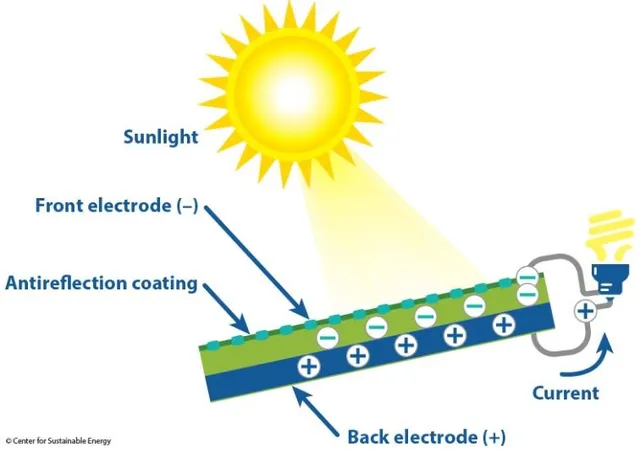Welcome to the transformative realm of solar energy, where sunlight becomes a boundless source of power through the ingenious workings of solar panels. In this journey, we demystify the intricate process, making the conversion of sunlight into electricity accessible to all. Picture the dance of photons, the liberation of electrons, and the guiding influence of silicon. Together, we’ll navigate the simple yet profound mechanics that illuminate our world with clean, sustainable energy. Join us as we explore the magic within solar panels, unlocking the secrets of how they harness the sun’s energy to power our homes and pave the way for a greener future.
Sunlight’s Dynamic Energy: Initiating the Process

Sunlight isn’t just a source of warmth; it’s a hidden treasure trove of energy! Solar panels unlock this treasure chest using light particles called photons. These photons, bombarding the solar panel’s surface, collide with silicon atoms – the workhorse material within each cell. The impact excites electrons within the silicon, knocking them loose from their usual positions. This sets off a chain reaction, as the freed electrons seek new partners, creating a current that flows throughout the panel. By cleverly harnessing this electron movement, solar panels convert light energy directly into electricity, a clean and sustainable alternative to traditional power sources.
Photovoltaic Marvel: Transforming Light into Electricity
“Visualize this: photons from the sun collide with the solar cells,” explained Dr. Laura Greene, a renewable energy specialist at SolarTech Innovations. “These cells are constructed from a unique material called silicon. When photons hit the silicon atoms, they transfer their energy to the electrons residing in these atoms. This energy transfer liberates the electrons, allowing them to move freely within the cell. This movement of electrons is the crux of the matter—it generates an electric current, which we recognize as electricity.”
Silicon’s Role as a Semiconductor: Guiding the Flow

While sunlight gets most of the credit, there’s another key player in solar panels: silicon. This remarkable material isn’t quite a conductor, nor an insulator – it’s a semiconductor. Imagine a conductor as an open highway for electricity, and an insulator as a roadblock. Silicon sits perfectly in between, acting like a traffic cop. When sunlight hits the silicon in solar cells, it disrupts the electrons’ usual positions. But unlike a conductor where electrons run wild, silicon channels this movement. It creates a one-way street for electrons, ensuring an orderly flow that generates electricity. This controlled flow is crucial for efficiently converting sunlight into usable power. So, next time you see a solar panel, remember the silent hero beneath the surface – silicon, the conductor who orchestrates the sunshine symphony
Direct Current to Alternating Current: The Inverter’s Contribution
The electricity generated in the solar cells emerges in the form of direct current (DC). However, most of our everyday devices operate on a different type of electricity—alternating current (AC). Enter the inverter, a crucial component that transforms DC into AC, making the electricity compatible with our appliances.
Synergy in Solar Panels: The Collective Power of Arrays
Imagine a single solar cell – it’s like a lone musician playing a melody. Now picture hundreds of these cells working together, like a full orchestra! That’s the power of solar arrays. These arrays are essentially many solar panels wired together. By combining their efforts, they generate a much larger amount of electricity. This makes solar power a viable option for powering our homes, businesses, and even entire communities. It’s like turning a single voice into a harmonious chorus, capturing the sun’s energy on a grand scale.
Optimizing Sun Exposure: The Art of Sun Tracking
To maximize energy production, certain solar panel systems incorporate sun-tracking mechanisms. These systems dynamically follow the sun’s trajectory throughout the day, ensuring that the panels maintain an optimal angle to receive the maximum sunlight. It’s akin to sunflowers turning their faces towards the sun.
Storing Solar Surplus: The Role of Batteries
Solar panels are fantastic sunshine collectors, but what happens when the clouds roll in? Here’s where battery backup comes in – it’s the secret weapon of solar power systems! Think of these batteries as sunshine reservoirs. During bright days, excess solar energy gets stored in the batteries, like squirrels stockpiling nuts for winter. Then, when the sun dips below the horizon or clouds hide its rays, the batteries kick in, supplying a steady stream of power. This ensures your home has clean energy, even on rainy days. Pretty neat, right? Solar panels and batteries working together – a sun-powered dream team!
Green Impact: Environmental Benefits of Solar Energy

Beyond its role in powering our gadgets and appliances, solar panels contribute significantly to environmental conservation. By transitioning away from conventional fossil fuels, solar energy reduces harmful emissions, fostering a cleaner and more sustainable planet. As technology progresses, the potential of solar power expands. Ongoing research is geared towards enhancing the efficiency of solar cells, developing flexible and transparent panels, and integrating solar technology into commonplace materials. The future holds promise for a world seamlessly powered by the sun.
Understanding the alchemy by which sunlight transforms into electricity unravels a pathway to a cleaner, brighter future. By comprehending the intricacies of solar panels, we empower ourselves to embrace sustainable energy solutions. Let’s continue to tap into the sun’s boundless energy, lighting up our world with the assurance of a sustainable and environmentally friendly energy future. For more such posts please visit our Technology section.



